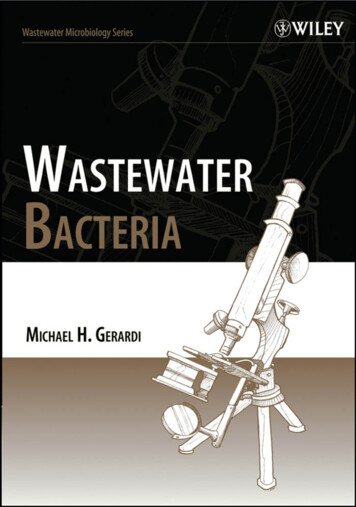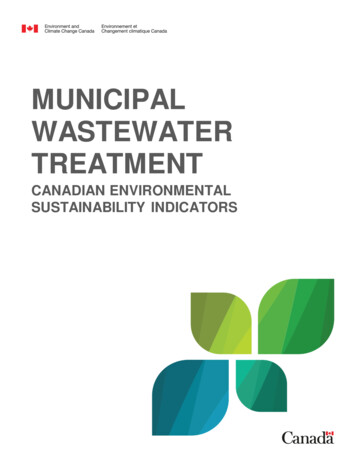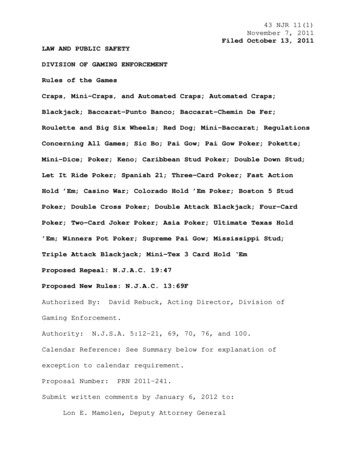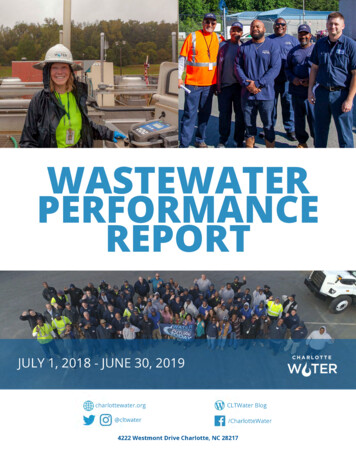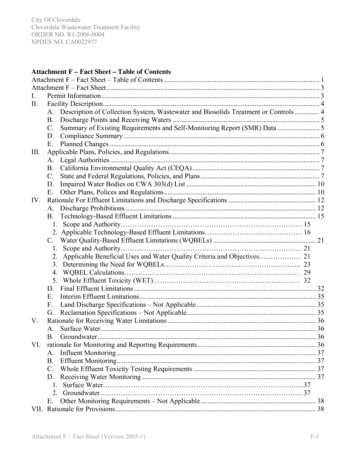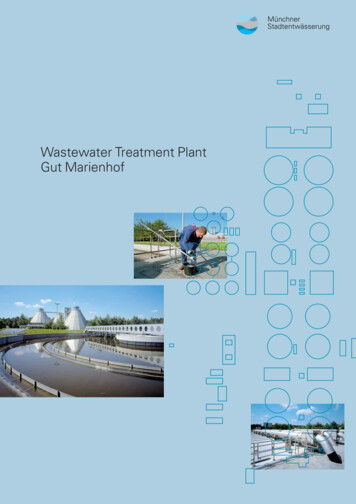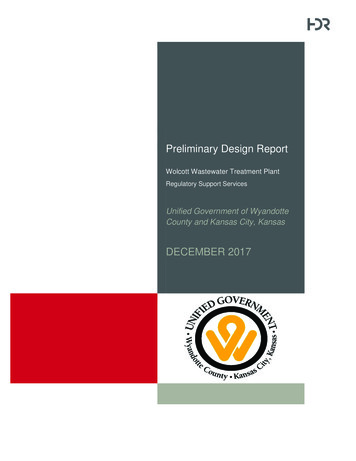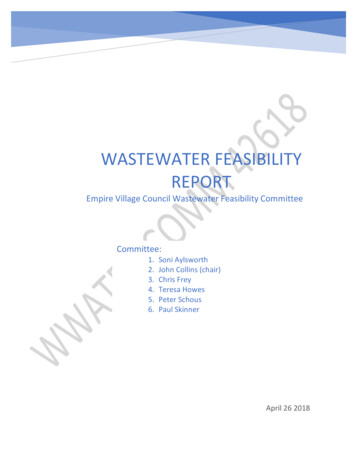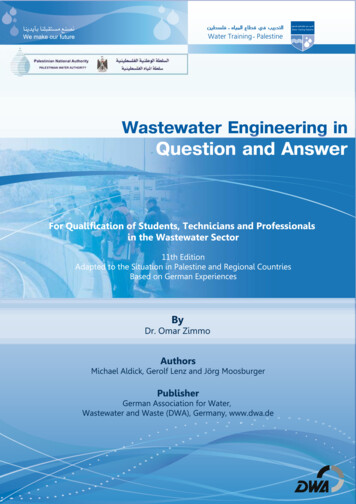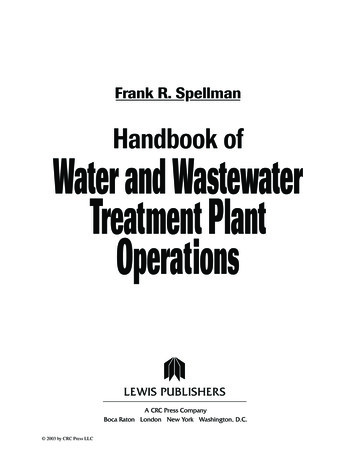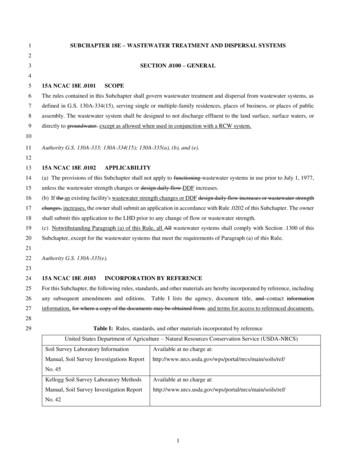
Transcription
SUBCHAPTER 18E – WASTEWATER TREATMENT AND DISPERSAL SYSTEMS12SECTION .0100 – GENERAL34515A NCAC 18E .0101SCOPE6The rules contained in this Subchapter shall govern wastewater treatment and dispersal from wastewater systems, as7defined in G.S. 130A-334(15), serving single or multiple-family residences, places of business, or places of public8assembly. The wastewater system shall be designed to not discharge effluent to the land surface, surface waters, or9directly to groundwater. except as allowed when used in conjunction with a RCW system.1011Authority G.S. 130A-333; 130A-334(15); 130A-335(a), (b), and (e).121315A NCAC 18E .0102APPLICABILITY14(a) The provisions of this Subchapter shall not apply to functioning wastewater systems in use prior to July 1, 1977,15unless the wastewater strength changes or design daily flow DDF increases.16(b) If the an existing facility's wastewater strength changes or DDF design daily flow increases or wastewater strength17changes, increases, the owner shall submit an application in accordance with Rule .0202 of this Subchapter. The owner18shall submit this application to the LHD prior to any change of flow or wastewater strength.19(c) Notwithstanding Paragraph (a) of this Rule, all All wastewater systems shall comply with Section .1300 of this20Subchapter, except for the wastewater systems that meet the requirements of Paragraph (a) of this Rule.2122Authority G.S. 130A-335(e).232415A NCAC 18E .0103INCORPORATION BY REFERENCE25For this Subchapter, the following rules, standards, and other materials are hereby incorporated by reference, including26any subsequent amendments and editions.27information, for where a copy of the documents may be obtained from. and terms for access to referenced documents.Table I lists the agency, document title, and contact information2829Table I: Rules, standards, and other materials incorporated by referenceUnited States Department of Agriculture – Natural Resources Conservation Service (USDA-NRCS)Soil Survey Laboratory InformationAvailable at no charge at:Manual, Soil Survey Investigations n/soils/ref/No. 45Kellogg Soil Survey Laboratory MethodsAvailable at no charge at:Manual, Soil Survey Investigation n/soils/ref/No. 421
Field Book for Describing and SamplingAvailable at no charge ain/soils/ref/copy orU. S. Government Publishing Office, P. O. Box 979050, St. Louis,MO, 63197-9000Guide to Soil Texture by Feel, Journal ofAvailable at no charge at:Agronomic detail/soils/edu/?cid nrcs142p2 054311National Engineering Handbook, Part 624Available at no charge at:(Drainage), Chapter 10 (Water il/mi/technical/engineerControl); Part 630 (Hydrology), Chaptering18; Part 650 (Engineering FieldHandbook), Chapter 14 (WaterManagement, Drainage)National Electrical Manufacturers Association1300 North 17th Street, Suite 900, Arlington, VA 22209www.nema.orgStandard 250 – Enclosures for ElectricalOne hundred twenty four dollars ( 124.00)EquipmentU. S. Environmental Protection Agency (EPA)U. S. EPA/NSCEPP. O. Box 42419, Cincinnati, OH 45242-0419Method 9080 – Cation Exchange CapacityAvailable at no charge at:of tateASTM International100 Barr Harbor Drive, P.O. Box C700, West Conshohocken, PA 19438-2959http://www.astm.orgC564 – Standard Specifications for RubberForty one dollars ( 41.00) each plus six dollars and seventy five centsGaskets for Cast Iron Soil Pipe and Fittings( 6.75) shipping and handlingC890 – Standard Practive for MinimumForty five dollars ( 45.00) each plus six dollars and ten cents ( 6.10)Structural Design Loading for Monolithicseventy five cents ( 6.75) shipping and handlingor Sectional Precast Concrete Water andWastewater StructuresC923 – Standard Specifications forForty one dollars ( 41.00) each plus six dollars and seventy five centsResilient Connectors Between Reinforced( 6.75) shipping and handlingConcrete Manhole Structures, Pipes, andLaterals2
C990 – Standard Specifications for JointsForty dollars ( 40.00) each plus six dollars and ten cents ( 6.10)for Concrete Pipe, Manholes, and Precastseventy five cents ( 6.75) shipping and handlingBox Sections Using Preformed FlexibleJoint SealantsC1644 – Standard Specification forForty five dollars ( 45.00) each plus six dollars and ten cents ( 6.10)Resilient Connectors Between Reinforcedseventy five cents ( 6.75) shipping and handlingConcrete On-Site Wastewater Tanks andPipesD448 – Standard Classification for Sizes ofThirty nine dollars ( 39.00) each plus six dollars and ten cents ( 6.10)Aggregate for Road and Bridgeseventy five cents ( 6.75) shipping and handlingConstructionD1784 – Standard Specification for RigidThirty nine ( 39.00) dollars each plus six dollars and ten cents ( 6.10)Poly (Vinyl Chloride) (PVC) Compoundsseventy five cents ( 6.75) shipping and handlingand Chlorinated Poly (Vinyl Chloride)(CPVC) CompoundsD1785 – Standard Specifications for PolyFifty dollars ( 50.00) plus six dollars and ten cents ( 6.10) seventy(Vinyl Chloride) (PVC) Plastic Pipe,five cents ( 6.75) shipping and handlingSchedules 40, 80, and 120D2241 – Standard Specification for PolyForty four dollars ( 44.00) each plus six dollars and ten cents ( 6.10)(Vinyl Chloride) (PVC) Pressure-Ratedseventy five cents ( 6.75) shipping and handlingPipe (SDR Series)D2466 – Standard Specification for PolyForty four ( 44.00) dollars each plus six dollars and ten cents ( 6.10)(Vinyl Chloride) (PVC) Plastic Pipeseventy five cents ( 6.75) shipping and handlingFittings, Schedule 40D2564 – Standard Specification forForty four dollars ( 44.00) each plus six dollars and ten cents ( 6.10)Solvent Cements for Poly (Vinyl Chloride)seventy five cents ( 6.75) shipping and handling(PVC) Plastic Piping SystemsD2729 – Standard Specification for PolyForty five dollars ( 45.00) each plus six dollars and ten cents ( 6.10)(Vinyl Chloride) (PVC) Sewer Pipe andseventy five cents ( 6.75) shipping and handlingFittingsD2774 – Standard Practice forForty four dollars ( 44.00) each plus six dollars and ten cents ( 6.10)Underground Installation of Thermoplasticseventy five cents ( 6.75) shipping and handlingPressure PipingD3034 – Standard Specification for TypeFifty dollars ( 50.00) each plus six dollars and ten cents ( 6.10)PSM Poly (Vinyl Chloride) (PVC) Sewerseventy five cents ( 6.75) shipping and handlingPipe and Fittings3
D6913 – Standard Test Methods forSixty five dollars ( 65.00) each plus six dollars and ten cents ( 6.10)Particle-Size Distribution (Gradation) ofseventy five cents ( 6.75) shipping and handlingSoils Using Sieve AnalysisD7928 – Standard Test Method forSixty five dollars ( 65.00) each plus six dollars and ten cents ( 6.10)Particle-Size Distribution (Gradation) ofseventy five cents ( 6.75) shipping and handlingFine-Grained Soils Using theSedimentation (Hydrometer) AnalysisF667 – Standard Specification for 3Forty five dollars ( 45.00) each plus six dollars and ten cents ( 6.10)through 24 in. Corrugated Polyethyleneseventy five cents ( 6.75) shipping and handlingPipe and FittingsNorth Carolina Administrative Code15A NCAC 01O – Environmental HealthAvailable at no charge 0rules.html15A NCAC 02C – Well ConstructionAvailable at no charge ubchapter%20c%20rules.pdf15A NCAC 02H – Procedures for Permits:Available at no charge 5a%20ncac%2002h%20.0101.pdf15A NCAC 02LAvailable at no charge %20l%20rules.pdf15A NCAC 02T – Waste Not DischargedAvailable at no charge at:to Surface ter%20t%20rules.pdf15A NCAC 02U – Reclaimed WaterAvailable at no charge at:4
u%20rules.pdf15A NCAC 08G – Authority:Available at no charge at:Organization: Structure: ubchapter%20g%20rules.pdf15A NCAC 13B – Solid WasteAvailable at no charge subchapter%20b%20rules.pdfNSF InternationalPO Box 130140, Ann Arbor, MI 48105http://www.nsf.org/Standard 40 – Residential Onsite SystemsOne hundred five dollars ( 105.00) each plus shipping and handlingInternational Association of Plumbing and Mechanical Officials (IAPMO)4755 E Philadelphia St, Ontario, CA MO/ANSI Z1000 – PrefabricatedOne hundred dollars ( 100.00) eachSeptic TanksCanadian Standards Association178 Rexdale Blvd, Toronto, ON Canada M9W 1R3http://www.csagroup.org/B66 – Design, material, and manufacturingOne hundred eighty dollars ( 180.00) each plus eighteen dollarsrequirements for prefabricated septic tanks( 18.00) shipping and handlingand sewage holding tanks2012 North Carolina Plumbing CodeAvailable at no charge at:https://codes.iccsafe.org/public/getpdf/2012 NC Plumbing.pdfhttp://www.ncdoi.com/OSFM/Engineering and Codes/Documents/2012 NCBuildingCode 015 North Carolina Building Code5
Available at no charge at:https://codes.iccsafe.org/public/getpdf/2015 NC ExistingBldg.pdfNorth Carolina Food Code ManualAvailable at no charge /NCFoodCodeManual-2009-FINAL.pdfU.S. Government Publishing Office732 North Capitol St, NW, Washington, DC 20401-0001https://bookstore.gpo.gov/40 CFR 136Sixty seven dollars ( 67.00) eachAmerican Association of State and Highway Transportation Officials (AASHTO)444 North Capital Street, NW, Suite 249, Washington, DC 20001https://www.transportation.org/Standard Specifications for HighwayThree hundred eighty dollars ( 380.00) each plus shipping andBridges (AASHTO H5 and H10)handling12Authority G.S. 130A-335(e).3415A NCAC 18E .0104ABBREVIATIONS5As used in this Subchapter, the following abbreviations mean:refer to:6(1)ABS: Acrylonitrile-Butadiene-Styrene;7(2)ACEC: Apparent Cation Exchange Capacity;8(3)ANSI: American National Standards Institute;9(4)ASTM: American Society for Testing and Materials;10(5)ATO: Authorization to Operate;11(6)BOD5:BOD: Five Day Biochemical Oxygen Demand;12(7)CA: Construction Authorization;13(8)CBOD: Carbonaceous Biochemical Oxygen Demand;14(9)CFR: Code of Federal Regulations;15(10)CSA: Canadian Standards Association;16(11)DDF: Design Daily Flow;17(12)DEQ: Department of Environmental Quality;18(13)DO: Dissolved Oxygen;19(13)(14) DIP: Ductile Iron Pipe;20(14)(15) DOT: Department of Transportation;21(15)(16) DSE: Domestic Strength Effluent;22(16)(17) EOP: Engineer Option Permit;6
1(17)(18) FOG: Fats, Oil, and Grease;2(18)(19) gpd: Gallons per Day;3(20)4(19)(21) IP: Improvement Permit;5(20)(22) IPWW: Industrial Process Wastewater;6(21)(23) LC: Limiting Condition;7(22)(24) LDP: Large Diameter Pipe;8(23)(25) LG: Licensed Geologist;9(24)(26) LHD: Local Health Department;HSE: High Strength Effluent;10(25)(27) LPP: Low Pressure Pipe;11(26)(28) LSS: Licensed Soil Scientist;12(27)(29) LTAR: Long Term Acceptance Rate;13(28)(30) mg/L: Milligrams/Liter;14(29)(31) NEMA: National Electrical Manufacturers Association;15(30)(32) NH3: Total Ammonia Nitrogen;16(31)(33) NOI: Notice of Intent to Construct;17(32)(34) NOV: Notice of Violation;18(33)(35) NSF: NSF International;19(34)(36) OP: Operation Permit;20(35)(37) PE: Professional Engineer;21(36)(38) PIA: Provisional, Innovative, and Accepted;22(37)(39) PPBPS: Prefabricated Permeable Block Panel System;23(38)(40) psi: Pounds per square inch;24(39)(41) PVC: Poly Vinyl Chloride;25(42)26(40)(43) RV: Recreational Vehicle;27(41)(44) RWTS: Residential Wastewater Treatment Systems;28(42)(45) SDR: Standard Dimension Ratio;29(46)30(43)(47) SWC: Soil Wetness Condition;31(44)(48) TKN: Total Kjeldahl Nitrogen;32(45)(49) TL: Trench Length;33(46)(50) TN: Total Nitrogen;34(47)(51) TSS: Total Suspended Solids;35(48)(52) TW: Trench Width;36(49)(53) USDA-NRCS: United States Department of Agriculture – Natural Resources Conservation Service;37(50)(54) VIP: Visual Inspection Protocol; andRCW: Reclaimed Water;SPI: Standard Precipitation Index;7
1(51)(55) WS: Water Supply Class.23Authority G.S. 130A-335(e).4515A NCAC 18E .01056The following definitions shall apply throughout this Subchapter:7(1)89DEFINITIONS"Aggregate" means naturally occurring inorganic material (crushed rock or gravel) screened to sizefor various uses.or other State approved media of a specific size or grade.(2)"Apparent Cation Exchange Capacity" (ACEC) means the sum of exchangeable bases plus total soil10acidity at a pH of 7.0. ACEC is expressed in milliequivalents per 100 grams of soil (meq/100g of11soil) or centimoles per kilogram of soil (cmols/kg of soil). The apparent soil ACEC is calculated by12determining the ACEC using the neutral normal ammonium acetate method, pH of 7.0 neutral13normal, and then dividing by the percent clay as determined by particle size distribution (pipette14method) and then multiplying by 100, as described in USDA-NRCS Soil Survey Laboratory15Information Manual, Soil Survey Investigations Report No. 45 and Kellogg Soil Survey Laboratory16Methods Manual, Soil Survey Investigation Report No. 42.17(3)1819"Approved" means that which the State or LHD has determined is in accordance with thisSubchapter and G.S. 130A, Article 11.(4)"Artificial drainage" means any man-made structure or device designed to overcome a soil wetness20conditionSWC or intercept lateral flowing ground or surface water. Artificial drainage systems21include the following: groundwater lowering system, interceptor drain, foundation drain, and22surface water diversion.23(5)"Authorized agent of the LHD" referred to as authorized agent, means a person who has been24authorized by the State in accordance with G.S. 130A, Article 4 and 15A NCAC 01O .0100 to permit25wastewater systems.26(6)2728for the installation, expansion, or repair of a proprietary wastewater system.(7)2930"Authorized designer" means a service provider authorized by the manufacturer who creates plans"Bed" means an excavation with a width greater than three feet containing dispersal media and oneor more laterals.(8)31"Bedroom" means any room defined as a sleeping room in the current North Carolina BuildingCode.32(9)"Berm" means a raised drainage feature used to divert stormwater runoff.33(9)“Building drain” means the lowest piping of a drainage system that receives the discharge from34waste pipes inside the design unit and extends to 10 ft beyond the walls of the building and conveys35the drainage to a building sewer.3637(10)“Building sewer” means the part of a drainage system that extends from the end of the buildingdrain and conveys the discharge to a wastewater system.8
1(10)(11) "Certified Inspector" means a person authorized to inspect a wastewater system at the time of sale2of a facility in accordance with G.S. 90A, Article 5, and applicable rules of the North Carolina On-3Site Wastewater Contractors and Inspectors Certification Board.4(11)(12) "Collection sewer" means gravity flow pipelines, force mains, effluent supply lines, manholes, lift5stations and all applicable appliances, used for conducting wastes from the sanitary building drain6or building sewer to and within a wastewater system. A collection system is a collection sewer.7The State has authority for the permitting of collection sewers when two or more design units have8a common collection sewer and the wastewater system is permitted under the Subchapter.9(12)(13) "Complete data set" means analytical results for all required influent and effluent constituents (as10specified in the effluent quality standard) for a specific site on a specific date. A data set may include11other constituents specified in an RWTS or PIA approval,Approval, permit, or other document.12(13)(14) "Composite sample" means commingled individual samples collected from the same point at13different times. Samples may be of equal volume or may be proportional to the flow at time of14sampling.15(14)(15) "Demand dosing" means a configuration in which a specific volume of effluent is delivered to a16component based upon patterns of wastewater generation from the source and dosing activation17elevation settings.18(15)(16) "Design daily flow" means the quantity of wastewater a facility is projected to produce in a 24-hour19period upon which wastewater system sizing and design are based as determined in Section .040020of this Subchapter.21(16)(17) "Design unit" means a discrete connection such as an individual dwelling unit, place of business, or22place of public assembly on which wastewater design daily flowsDDF are based. Multiple design23units can comprise a facility.2425(17)(18) "Dispersal field" means physical location where final treatment and dispersal of effluent occurs inthe soil.26(18)(19) "Dispersal media" means the media used to provide void space through which effluent flows and is27stored prior to infiltration (e.g., washed gravel or crushed stone, polystyrene aggregate,products28referenced in Section .0900, products approved pursuant to Section .1700, chambers, pipe, drip29tubing with emitters, etc.).3031(19)(20) "Dose volume" means an amount of effluent delivered during a dosing event as determined by theactivation levels in a demand dosing system or by a timer in a time dosing system.32(20)(21) "Dwelling unit" means any room or group of rooms located within a structure and forming a single,33habitable unit with facilities which are used or intended to be used for living, sleeping, bathing,34toilet usage, cooking, and eating.3536(21)(22) "Effluent" means the liquid discharge from a pretreatment component.as defined in G.S. 130A334(7b).9
1(22)(23) "Facility" means one or more design units located on a single or multiple lot(s) or tract(s) of land2and served by a common wastewater system comprised of one or more ground absorption systems.3(23)(24) "Finished grade" means the final elevation of the land over the wastewater system after installation.4(24)(25) "Flood pool elevation" means the maximum water surface elevation of a reservoir, equal to the56elevation of the spillway.(25)(26) "Flow equalization" means a system configuration that includes sufficient storage capacity to allow7for uniform flow to a subsequent component despite variable flow from the source.8(26)(27) "Full kitchen" means all the appliances in a warming kitchen plus a warewashing machine or9equipment.the appliances meet the requirements of North Carolina Food Code, Chapters 4-1 and 4-102. The wastewater system for a facility with a full kitchen shall include a grease trap, the dispersal11field LTAR shall not exceed the mean for the applicable soil group, and no dispersal field reduction12in size.13(27)(28) "Grab sample" means a discrete sample collected at a specific time and location.14(29)1516“Grease tank” means the tank located outside the facility that is used to reduce the amount of greasebeing discharged to a wastewater system.(30)17“Grease trap” means a device used inside the facility, generally under the sink, to reduce the amountof grease being discharged to a wastewater system.18(28)(31) "Gravity distribution" means gravity delivery of effluent to and within each lateral.19(29)(32) "Groundwater lowering system" means a type of artificial drainage system designed to lower the20water table by gravity or in conjunction with a pump to maintain the vertical separation distance21beneath a dispersal field.22(30)(33) "Horizon" means a layer of soil, approximately parallel to the surface that has distinct physical,23chemical, and biological properties or characteristics such as color, structure, texture, consistence,24kinds and number of organisms present, degree of acidity or alkalinity, etc, resulting from soil25forming processes.26(31)(34) "Infiltrative surface" means the designated interface where effluent moves from dispersal media or27a distribution device into treatment media, naturally occurring soil, or fill.“Influent” means the sewage discharged to pretreatment as defined in G.S. 130A-334(7b).28(35)29(32)(36) "Installer" means a person authorized to construct, install, or repair a wastewater system in30accordance with G.S. 90A, Article 5 and applicable rules of the North Carolina On-Site Wastewater31Contractors and Inspectors Certification Board.32(33)(37) "Interceptor drain" means a type ofsubsurface artificial drainage designed to intercept and divert33lateral moving groundwater or perched water away from the dispersal field or other system34component to an effective outlet. Interceptor drains are a type of artificial drainage. An interceptor35drain can also be a foundation drain.36(34)(38) "Invert" means the lowest elevation of the internal cross-section of a pipe, fitting, or component.10
12(35)(39) "Jurisdictional wetland" means land established as a wetland by DEQ or the US Army Corp ofEngineers under Section 404 of the Federal Clean Water Act.3(36)(40) "Ksat" or saturated hydraulic conductivity, means the value of water flow (flux) through a unit cross4sectional area of soil under saturated conditions. In-situ Ksat is measured in the field using clean5water. Results of in-situ Ksat are used to simulate movement of effluent through the soil and may6be used to field verify LTAR.7(37)(41) "Lateral water movement" means the movement of subsurface water down gradient often associated8with a less permeable horizon. Lateral water movement can be observed in a bore hole, excavation,9or monitoring well on sloping sites.1011(38)(42) "Lateral" means any pipe, tubing, or other device used to convey and distribute effluent in a dispersalfield.12(39)(43) "Limiting condition" means soil conditions (morphology, wetness, depth, restrictive horizon, or13organic matter content) or site features (topography, slope, landscape position, or available space)14that restrict design options or prohibit permitting a wastewater system.1516(40)(44) "Lithochromic feature" means soil mottle or matrix associated with variations of color due toweathering of parent materials.17(41)(45) "Long Term Acceptance Rate," referred to as LTAR, means the rate of effluent absorption by the18soilsoil, fill, or saprolite in a wastewater system after long-term use. The LTAR, in units of gallons19per day per square foot (gpd/ft2), is assigned based upon soil textural class, structure, consistence,20depth, percent coarse rock, landscape position, topography, and system type, and is used to21determine the dispersal field sizing requirements, in accordance with applicable rules of this22Subchapter.2324(42)(46) "Local health department," referred to as LHD, means any county, district, or other healthdepartment authorized to be organized under the General Statutes of North Carolina.25(43)(47) "Management Entity" means the person, entity, company, or firm designated by the owner of the26wastewater system who has primary responsibility for the operation of a wastewater system in27accordance with this Subchapter, G.S. 90A, Article 3, and applicable rules of the Water Pollution28Control System Operators Certification Commission. The Management Entity can be the owner, a29public Management Entity, a certified operator, a management company, or an entity that employs30certified operators. The Management Entity is or employs the operator in responsible charge for the31wastewater system.32(44)(48) "Mass loading" means the total mass of one or more organic or inorganic effluent constituents33delivered to the wastewater system over a specified period. It is computed by multiplying the total34volume of flow during the specified period by the flow-weighted average constituent concentration35in the same period. Units of measurement are pounds per day.36(45)(49) "Matrix" means a volume of soil equivalent to 50 percent or greater of the total volume of a horizon.11
1(46)(50) "Mean high-water mark" or normal high-water mark, means, for coastal waters having six inches or2more lunar tidal influence, the average height of the high-water over a 19-year period as may be3ascertained from National Ocean Survey, U.S. Army Corps of Engineers tide stations data, or as4otherwise determined under the provisions of the Coastal Area Management Act. The most stringent5high-water mark shall be applied.67(47)(51) "Media" means a solid material that can be described by shape, dimensions, surface area, void space,and application.8(48)(52) "Mottle" means subordinate color of a differing Munsell color system notation in a soil horizon.9(49)(53) "Naturally occurring soil" means soil formed in place due to natural formation processes and being10unaltered by filling, removal, or other artificial modification other than tillage.11(50)(54) "NEMA 4X" means an enclosure for an electrical control panel or junction box that meets standards12for protection of equipment due to the ingress of water (including rain and hose-directed water) and13an additional level of protection against corrosion, as set forth in NEMA Standard 250.14(51)(55) "NSF-40 systems" means individual residential wastewater treatment systems (RWTS) that are15approved and listed in accordance with the standards adopted by NSF International for Class I16residential wastewater treatment systems under NSF-ANSI Standard 40 and approved for use in17accordance with G.S. 130A-342 and the rules of this Subchapter.18(52)(56) "Non-ground absorption system" means a system for waste treatment designed not to discharge to19the soil, land surface, or surface waters, including approved vault privies, incinerating toilets,20mechanical toilets, composting toilets, chemical toilets, and recycling systems.21222324(53)(57) "Off-site system" means a wastewater system where any system component is located on propertyother than the lot the facility is located on.(54)(58) "Organic soils" means those organic mucks and peats consisting of more than 20 percent organicmatter, by dry weight, and 18 inches or greater in thickness.25(55)(59) "Owner" means owner or owner's representative who is a person holding legal title to the facility,26wastewater system, or property or who holds power of attorney to act on the owner's behalf. The27owner shall own or control the wastewater system.28designated by letter or contract to act on the owner's behalf.2930The owner's representative is an agent(56)(60) "Parallel distribution" means the distribution of effluent that proportionally loads multiple sectionsof a dispersal field at one time.31(57)(61) "Parent material" means the mineral matter that is in its present position through deposition by water,32wind, gravity or by decomposition of rock.rock and has not gone through the soil forming process.33(58)(62) "Ped" means a unit of soil structure, such as blocky, granular, prismatic, or platy formed by natural34processes, in contrast to a clod, which is formed artificially.35(59)(63) "Perched water table" means a zone of saturation held above the main groundwater body by a36slowly-permeable layer, impermeable rock, or sediment, which may or may not exhibit37redoximorphic features.12
1(60)(64) "Person" means any individual, firm, association, organization, partnership, business trust,2corporation, company, or unit of local government.3(61)(65) "Pressure dispersal" means an approved system utilizing an effluent pump or siphon to distribute4effluent uniformly to the infiltrative surface in the dispersal field through a pressurized pipe network.5(62)(66) "Pressure dosed gravity distribution" means pressure delivery of effluent to a manifold,6dissipatordistribution box, or other splitter with subsequent gravity distribution within one or more7laterals to the infiltrative surface.8(63)(67) "Public management entity" means a city (G.S. 160A, Article 16), county (G.S. 153A, Article 15),9interlocal contract (G.S. 153A, Article 16), joint management agency (G.S. 160A, Articles 461 and10462), county service district (G.S. 153A, Article 16), county water and sewer district (G.S. 162A,11Article 6), sanitary district (G.S. 130A, Article 2), water and sewer authority (G.S. 162A, Article 1),12metropolitan water district (G.S. 162A, Article 4), metropolitan sewerage district (G.S. 162A,13Article 5), public utility [G.S. 62-3(23)], county or district health department (G.S. 130A, Article142), or other public entity legally authorized to operate and maintain wastewater systems.15(68)“Raw sewage lift stations” means a dosing system that is designed to move untreated sewage from16a lower elevation to a higher elevation. Raw sewage lift stations are generally installed prior to any17wastewater treatment.1819(69)“RCW systems” means advanced pretreatment systems which are approved in accordance withRCW effluent standards in Rule .1002 of this Subchapter.20(64)(70) "Redoximorphic features" means a color pattern of a
1 1 SUBCHAPTER 18E - WASTEWATER TREATMENT AND DISPERSAL SYSTEMS 2 3 SECTION .0100 - GENERAL 4 5 15A NCAC 18E .0101 SCOPE 6 The rules contained in this Subchapter shall govern wastewater treatment and dispersal from wastewater systems, as 7 defined in G.S. 130A-334(15), serving single or multiple-family residences, places of business, or places of public
